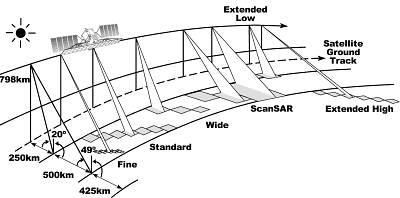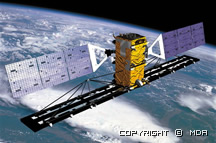- C band Synthetic aperture Radar (SAR)
- Orbit launch date: 04 November 1995
- 5 years design life
- 7 different beam modes
- Resolution is between 8 - 100 km
- Frequently Acqusition ve Emergency discovery
- Programming on emergency and priority conditions
- Real-time data analysis
-Data Calibration on the studies of Change Detection
RADARSAT has a SAR instrument with following properties:
- C band wavelength (5.6cm)
- HH polarization
- Right-sided steerable antenna
- 7 differen beam modes and 35 beam positions
- Wide range ScanSar capacity
- More than one imaging types
RADARSAT can collect data over 1175km2 width by using 7 different beam modes. This gives users flexibility for the desired acqusitions.
For more information:http://www.asc-csa.gc.ca/eng/satellites/radarsat1/
Beam Modes:
 |
 Signal Data |
 Single Look Complex |
 Path Image |
 Path Image Plus |
 Map Image |
|
|
|
| Fine | ||||||||
| Standard | ||||||||
| Wide | ||||||||
| ScanSAR Narrow | ||||||||
| SpanSAR Wide | ||||||||
| Extended High | ||||||||
| Extended Low | ||||||||
|
|||||||||||||||||||||
Radarsat 1 Products |
|||||||||||||||||||||
|
|||||||||||||||||||||


